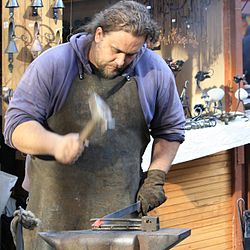Blacksmithing

A modern blacksmith at work.
|
|
| Occupation | |
|---|---|
|
Occupation type
|
Profession |
|
Activity sectors
|
Vocation |
| Description | |
| Competencies | Physical strength, conceptualization |
|
Related jobs
|
Farrier |
A blacksmith is a metalsmith who creates objects from wrought iron or steel by forging the metal, using tools to hammer, bend, and cut (cf. whitesmith). Blacksmiths produce objects such as gates, grilles, railings, light fixtures, furniture, sculpture, tools, agricultural implements, decorative and religious items, cooking utensils and weapons.
While there are many people who work with metal such as farriers, wheelwrights, and armorers, the blacksmith had a general knowledge of how to make and repair many things, from the most complex of weapons and armor to simple things like nails or lengths of chain.
The "black" in "blacksmith" refers to the black fire scale, a layer of oxides that forms on the surface of the metal during heating. The origin of "smith" is debated, it may come from the old English word "smythe" meaning "to strike" or it may have originated from the Proto-German "smithaz" meaning "skilled worker."
Blacksmiths work by heating pieces of wrought iron or steel until the metal becomes soft enough for shaping with hand tools, such as a hammer, anvil and chisel. Heating generally takes place in a forge fueled by propane, natural gas, coal, charcoal, coke or oil.
Some modern blacksmiths may also employ an oxyacetylene or similar blowtorch for more localized heating. Induction heating methods are gaining popularity among modern blacksmiths.
Color is important for indicating the temperature and workability of the metal. As iron heats to higher temperatures, it first glows red, then orange, yellow, and finally white. The ideal heat for most forging is the bright yellow-orange color that indicates forging heat. Because they must be able to see the glowing color of the metal, some blacksmiths work in dim, low-light conditions, but most work in well-lit conditions. The key is to have consistent lighting, but not too bright. Direct sunlight obscures the colors.
...
Wikipedia
